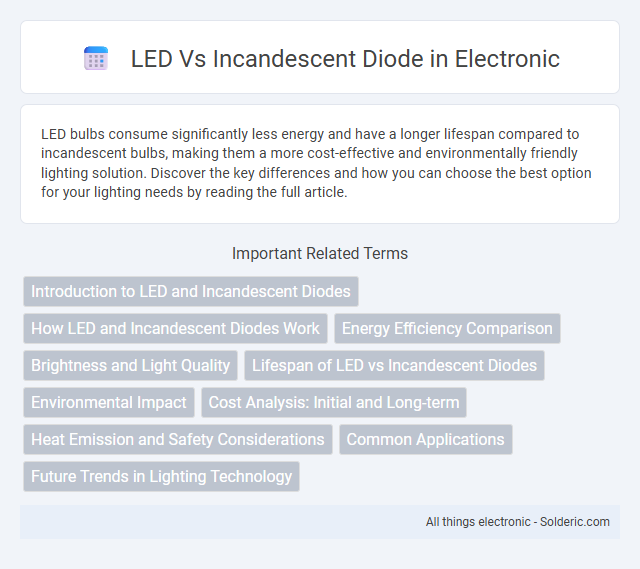LED bulbs consume significantly less energy and have a longer lifespan compared to incandescent bulbs, making them a more cost-effective and environmentally friendly lighting solution. Discover the key differences and how you can choose the best option for your lighting needs by reading the full article.
Comparison Table
| Feature | LED | Incandescent Diode |
|---|---|---|
| Light Source Type | Light Emitting Diode (LED) | Incandescent filament bulb |
| Energy Efficiency | High (up to 90% more efficient) | Low (high energy consumption) |
| Lifespan | 25,000 - 50,000 hours | 1,000 - 2,000 hours |
| Heat Emission | Low heat generated | High heat generated |
| Durability | Robust, shock-resistant | Fragile, prone to breakage |
| Color Options | Wide range, adjustable | Limited, warm white only |
| Switch-On Time | Instant light | Warm-up time required |
| Environmental Impact | Low, recyclable components | Higher, contains more waste heat |
| Cost | Higher upfront, lower long-term | Lower upfront, higher long-term |
Introduction to LED and Incandescent Diodes
LEDs (Light Emitting Diodes) are semiconductor devices that emit light when an electric current passes through them, offering high energy efficiency, longer lifespan, and lower heat output compared to incandescent diodes. Incandescent diodes, often referred to as incandescent bulbs or filaments, generate light by heating a tungsten filament until it glows, resulting in higher energy consumption and shorter operational life. The technological distinction between LEDs and incandescent diodes significantly impacts lighting applications, with LEDs favored for sustainable and cost-effective solutions.
How LED and Incandescent Diodes Work
LEDs (Light Emitting Diodes) produce light through electroluminescence, where electrons recombine with holes in a semiconductor material, releasing energy in the form of photons. Incandescent bulbs generate light by passing an electric current through a tungsten filament, heating it until it glows and emits visible light. LED technology offers higher energy efficiency and longer lifespan compared to the heat-dependent light emission of incandescent diodes.
Energy Efficiency Comparison
LED lights consume up to 80% less energy compared to incandescent bulbs, making them significantly more energy-efficient for your lighting needs. Incandescent bulbs convert most energy into heat rather than light, resulting in higher electricity usage and shorter lifespan. Choosing LEDs reduces energy bills and environmental impact while providing longer-lasting illumination.
Brightness and Light Quality
LED bulbs provide higher brightness measured in lumens per watt, delivering more light output with less energy consumption compared to incandescent bulbs. The light quality of LEDs is often superior, offering adjustable color temperatures from warm to cool white, whereas incandescent bulbs emit a consistent warm yellow light. Your choice of LED lighting ensures enhanced brightness and customizable light quality, improving both energy efficiency and ambiance.
Lifespan of LED vs Incandescent Diodes
The lifespan of LED diodes significantly outperforms incandescent diodes, with LEDs lasting up to 25,000 to 50,000 hours compared to the 1,000 to 2,000 hours typical for incandescent bulbs. This extended longevity reduces the frequency of replacements, lowering maintenance costs and energy consumption over time. Choosing LED technology enhances the durability and efficiency of Your lighting solutions.
Environmental Impact
LED bulbs consume up to 85% less energy and last 25 times longer than incandescent bulbs, significantly reducing carbon emissions and landfill waste. The lower heat output of LEDs also minimizes energy loss, enhancing overall sustainability. Choosing LED lighting supports your efforts toward a greener, more environmentally friendly lifestyle.
Cost Analysis: Initial and Long-term
LED bulbs typically have a higher initial cost compared to incandescent bulbs, but their energy efficiency and longevity result in significantly lower electricity bills and replacement expenses over time. Incandescent bulbs consume more power and have shorter lifespans, leading to frequent replacements and increased long-term costs. Your investment in LEDs translates into substantial savings and reduced maintenance, making them a more cost-effective choice in the long run.
Heat Emission and Safety Considerations
LED bulbs emit significantly less heat compared to incandescent bulbs, as they convert a higher percentage of energy into light rather than heat, resulting in lower surface temperatures during operation. This reduced heat emission enhances safety by minimizing the risk of burns and decreasing the likelihood of fire hazards in residential and commercial settings. Furthermore, LEDs' lower heat output contributes to longer lifespan and improved energy efficiency, making them a safer and more sustainable lighting option.
Common Applications
LED diodes are widely used in energy-efficient lighting, digital displays, and automotive headlights due to their durability and low power consumption. Incandescent diodes, known for their warm light and lower initial cost, are commonly found in traditional household bulbs, decorative lighting, and heat lamps. Your choice between LED and incandescent impacts energy savings, maintenance frequency, and environmental footprint.
Future Trends in Lighting Technology
LED lighting technology is rapidly advancing with innovations such as smart integration, energy efficiency improvements, and longer lifespan compared to traditional incandescent bulbs. Emerging trends include tunable color temperatures, enhanced brightness control, and IoT-enabled lighting systems that adapt to user preferences and environmental conditions. Your choice of lighting will increasingly benefit from reduced energy consumption and sustainable design, positioning LED as the dominant future trend over incandescent diodes.
LED vs Incandescent diode Infographic

 solderic.com
solderic.com